Oracle has announced it will buy Sun Microsystems for $7.4 billion, in agreed acquisition that the company’s CEO Larry Ellison claims will “transform the IT industry".
The unlikely combination will add server, storage, Java software and open source database units to Oracle's stable of database, applications and middleware, and comes after many months of on-off talks between Sun and IBM.
A triumphant Ellison suggested Oracle would move to sell unified IT environments form front-end software to underlying hardware: “Oracle will be the only company that can engineer an integrated system – applications to disk – where all the pieces fit and work together so customers do not have to do it themselves,”.
The deal carries wide ramifications for Sun customers, and will put Oracle in direct competition with some of its closest partners: NetApp and EMC in storage and HP and Dell in servers are just a few examples. There will also be confusion among users of the open source database product, MySQL, acquired by Sun for $1 billion in early 2008.
However, industry insiders suggest that Oracle may offload parts of Sun's unprofitable hardware portfolio – for example, selling its proprietary Sun SPARC Enterprise server range to Fujitsu, which co-develops and resells the systems.
Of more interest were Java and Solaris, which held “substantial long-term strategic customer advantages,” the company said.
Oracle stressed that it was particularly thrilled to get its hands on Java: Java is "one of the industry’s best known brands and most widely deployed technologies, and the most important software Oracle has ever acquired. Oracle Fusion Middleware, Oracle’s fastest growing business, is built on top of Sun’s Java language and software. Oracle can now ensure continued innovation and investment in Java technology for the benefit of customers and the Java community,” the company said in a statement.
Sun’s chairman and co-founder Scott McNealy described the event as “a natural evolution of our relationship and an industry-defining event”, while Jonathan Schwartz, Sun’s CEO, said it as a “fantastic day for Sun’s customers, developers, partners and employees across the globe, joining forces with the global leader in enterprise software to drive innovation and value across every aspect of the technology marketplace.”
“From the Java platform touching nearly every business system on earth, powering billions of consumers on mobile handsets and consumer electronics, to the convergence of storage, networking and computing driven by the Solaris operating system and Sun’s SPARC and x64 systems. Together with Oracle, we’ll drive the innovation pipeline to create compelling value to our customer base and the marketplace,” he said.
Until recently IBM was in advanced talks with Sun, but is said to have withdrawn from negotiations after consultation with US and European regulators indicated that any deal would be subject to intensive scrutiny by law-makers.
The end for 25-year-old Sun, one of Silicon Valley's, comes after a flood of red ink, topped by the posting of a $1.7 billion loss in its quarter to 30 September 2008. It has also announced it will shed between 5000 and 6000 jobs, approximately 18% of its workforce.
Sources quoted by the Wall Street Journal in mid-March suggested IBM was close to paying upward of least $6.5 billion for Sun – almost twice the company's market capitalisation at the time, but only half its total revenues in the 2008 financial year – testament to the fact that investors have little faith in Sun’s ability to make money this year.
Nonetheless, Oracle predicts the acquisition will boost its overall operating income by $1.5 billion in the first year after the deal has closed, and $2 billion in the following year. Oracle’s president Safra Catz said, “this would make the Sun acquisition more profitable in per share contribution in the first year than we had planned for [Oracle’s previous] acquisitions of BEA, PeopleSoft and Siebel combined.”










